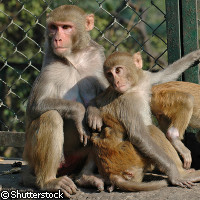Evolution: it's in the eye of the beholder
Which facial feature do humans look at to distinguish the faces of people they know from those they don't? Somewhat unsurprisingly, the eyes are the characteristic we first observe in another person's face that allows us to recognise them. What may come as a surprise, however, is that our fellow primates, monkeys, do the same thing. Studies conducted at the Max Planck Institute for Biological Cybernetics in Germany confirm that, like humans, rhesus monkeys use the same strategies to scan for recognition in members of the same species. The finding adds an important piece to science's age-old puzzle of human evolution. Arguably one of the greatest contributors to science, the naturalist Charles Darwin, studied the facial expressions of monkeys in his quest to prove that all species, including humans, evolved from common ancestors. Ever since then, scientists have sought to understand just how closely related humans are to monkeys, and now and then their efforts uncover evidence that is gripping enough so as to close the gap that divides the two primates ever so slightly. The results of this latest study, published in Current Biology, show that both humans and rhesus monkeys look predominantly at the eyes of conspecifics (members of the same species) to process recognition. What's more, when it comes to non-conspecifics (members of a different species) both humans and monkeys move away from the eyes and let their gaze drift to other parts of the face; this also holds true for both species when presented with an image of a same-species face that is upside down, and therefore harder to recognise. The two main authors of the study, Christian Wallraven and Christoph Dahl, have shown that the processing strategy whereby humans look at the eyes only of other humans, and monkeys only the eyes of other monkeys, takes place despite the fact that the two species share comparable facial features, such as similar eyes, nose and mouth. Humans, it seems, are authorities on human faces, and monkeys are authorities on monkey faces, but not for one another. 'Humans and monkeys are therefore even more similar than previously thought,' said Dr Dahl. The results suggest that the same perceptual mechanisms were developed during evolution for both species, and that the ability to process faces of conspecifics was an important strategy to be passed onto the next of kin. To reach these findings, the scientists recorded the eye movements of both humans and rhesus monkeys while faces of the two species were presented, both 'right-side up' and 'upside-down'. The latter were used as a control; it is widely accepted in the field of perceptual psychology that inverted faces are difficult to recognise, and that the usual machinery that processes information stops working.
Countries
Germany



